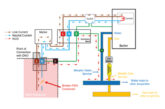
Scott Brewer, Head of Technical at Knightsbridge, looks at some key safety considerations when it comes to providing power and light outdoors.
When your customers are looking to enhance their gardens with water features, lighting, plus access to power in the garden for tools, appliances and leisure, there are two main elements to providing power in the garden: safety and, with lighting, design and aesthetics.
Since April 2013 electrical work in a dwelling, or associated with its surroundings, is notifiable to a to a local building control body where the work includes: the installation of a new circuit, whether at low voltage (typically 230V) or extra-low voltage); or the replacement of a consumer unit or any addition or alteration to a circuit in a special location.
Part P of the Building Regulations applies to fixed electrical installations in dwellings (including gardens and shared amenities in blocks of flats, and any building that shares its electricity supply with a dwelling).
Gardens do not feature among the 18th Edition’s ‘Special Locations’. However, you can refer to Sections 702 (swimming pools), 705 (agricultural and horticultural locations) and 714 (outdoor lighting installations) for analogous guidance.
Switches, sockets and accessories should be purpose-designed and Ingress Protected (IP) against the entry of objects, accidental contact or water. An IP rating consists of two digits: the first from zero to six and the second from zero to nine.
The first refers to the size of object that could enter an enclosure. The second indicates the level of protection against liquids. The highest ratings refer to a capacity for immersion, for such applications as ponds.
For sockets and switches, IP66 is a prudent minimum. This means they’re protected against dust, any possibility of contact and powerful jets of water. Sockets should have integral 30mA RCD protection or be on an RCD/ RCBO protected circuit.
It’s not recommended to take the garden circuit off an existing circuit through a fused spur. Ideally, the supply to the garden should be an independent circuit with an independent RCD or RCBO so that, if faults occur, tripping doesn’t affect the rest of the house. Any new circuit becomes notifiable under Part P, as above.
Electrical equipment for use with ponds and water features should be IPX7 or higher. Pumps should comply with BS EN 60335-2-41:2003+A2:2010 and ground recess lighting with BS EN 60598-2-13:2006+A2:2016. Larger ponds may be subject to Section 702 of BS 7671, as above.
To avoid damage from rodents and accidental damage, cables for power and lighting should be either armoured and/or buried in a suitably robust ducting. Oversizing ducting will make cable pulling easier and allow for future-proofing, to the extent of laying extra cable that can extend a scheme later.
Standard twin and earth PVC cables aren’t suitable for permanent use outdoors. The sheath of this cable (grey or white) has limited resistance to UV radiation, but isn’t specifically designed for installation in direct sunlight or outdoors.
Safety concerns surrounding exterior lighting is the same as those for wiring devices, and Section 714 of BS 7671 will provide guidance, despite it applying to commercial and public installations.
IP ratings for lighting don’t need to be as stringent as wiring devices because of the nature of the products, locations – which may be raised, or embedded – and nature of use. They range from IP44 for high level LED security lights, IP54 for wall-mounted luminaires through to IP67 or IP68 for LED spike and groundlights.
Maintenance is a key consideration, and provision should be made for it, either by location, power supply (by plug and IP socket) or excess cabling; especially access to lamps for replacement purposes.
The intended usage of garden lighting needs to be considered and the scheme designed accordingly. Does the customer want floods to wash the rear of the house, LED decklights to light a social space, a water feature to be accented through submersible lights, or ambient lighting to highlight a feature such as a statue?
Having established a schematic and the effects desired, the products will suggest themselves.
Quality lighting, thoughtfully designed and installed by professionals can really enhance the aesthetic of a home and its outdoor space. Lighting is a great way of creating versatile spaces both inside and out, especially on good weather days like these.
View the 2020 Knightsbridge product catalogue by clicking here










